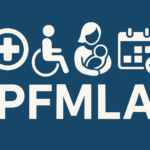Beginning Jan. 1, 2026, Minnesota will implement the Paid Family and Medical Leave (PFMLA) program, which provides paid time off and job protection for eligible employees who need to care for a new child, recover from a serious health condition, or care for a family member with a serious health condition.
This new law is similar to the federal Family and Medical Leave Act (FMLA) in terms of qualifying events, but it differs by providing paid benefits to eligible employees. Nearly all employees, including full-time, part-time, and seasonal workers, are covered.
Eligibility
To qualify, employees must:
- Have earned at least $3,700 in 2025 (approximately 5.3% of the state’s average annual wage).
- Experience a qualifying event lasting at least seven consecutive days.
Benefit Entitlement
Employees may take up to:
- 12 weeks of Medical Leave: For recovery from a serious health condition, including childbirth.
- 12 weeks of Family Leave: For bonding with a new child (birth, adoption, or foster care), or caring for a family member with a serious health condition.
If both apply, employees may take a combined maximum of 20 weeks per benefit year. Intermittent leave of up to 480 hours per year (the equivalent of 12 weeks) is also permitted. If an employee qualifies for the full 20 weeks, that additional time must be taken in one continuous block.
Wage Replacement: Employees will receive between 55% and 90% of their regular wages while on leave, with a maximum weekly benefit of $1,423 (based on the current state average wage).
Funding: The program is funded through a 0.88% payroll tax, shared equally between employers and employees.
Program Details
- Effective Date: Jan. 1, 2026
- Benefit Year: Begins on the first day leave is taken.
- Certification: Employees are required to submit a form from their healthcare or service provider to certify their need for each leave.
- Job Protection: Employees are entitled to reinstatement to the same or an equivalent position upon return from leave if the employee has been in their position for at least 90 days before the start of their leave.
- Health Insurance: Employer-paid portions of health and group insurance premiums will continue during leave; employees remain responsible for their share.
- Non-Retaliation: Employers may not interfere with or retaliate against employees for using Paid Leave.
Impact on University Policies
This new program will increase the university’s total payroll expenditure by approximately $132,000 annually.
With the new Minnesota Paid Family Leave, employees are covered for up to 800 hours (20 weeks) if their condition qualifies.
To align university leave programs with this new state benefit and maintain financial sustainability, the following changes will take effect:
- Earned Sick and Safe Time Leave
-
- Effective Jan. 1, 2026, all full-time staff will receive 80 hours of sick and safe leave annually.
- Existing balances above 80 hours will be frozen until usage reduces the balance below that threshold.
- Personal Paid Leave Day will be discontinued after Dec. 31, 2025.
- Paid Parental Leave
-
- The current 20-working-day Paid Parental Leave will be discontinued after Dec. 31, 2025.
- Employees currently using Paid Parental Leave will transition to PFMLA on Jan. 1, 2026.
- Supplemental Pay Option
-
- Employees may use accrued sick or vacation time to supplement PFMLA pay.
Plan Administration
Saint Mary’s University has contracted with UNUM to administer an approved equivalent Paid Family and Medical Leave plan, rather than participating in the State of Minnesota’s program. This equivalent plan provides the same benefits and legal protections as the state plan, with the added advantage of enhanced service and support for our university community.
Please use the links below to access the required notices:
- Equivalent Plan Notice
- Workplace Paid Leave Poster – Employee Acknowledgment Form (This form will be distributed electronically for all employees to sign as required by law.)
Summary
The Minnesota Paid Family Leave program expands employee benefits while requiring updates to existing University policies to prevent duplication and ensure financial sustainability. These adjustments balance compliance with state law and equitable benefit access for all employees.


